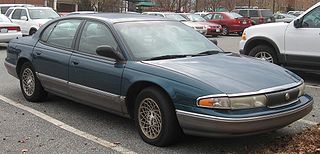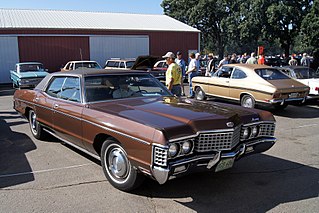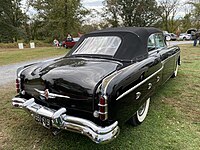
Packard was an American luxury automobile company located in Detroit, Michigan. The first Packard automobiles were produced in 1899, and the last Packards were built in South Bend, Indiana in 1958.

The Chrysler 300 "letter series" are high-performance personal luxury cars that were built by Chrysler in the U.S. from 1955 to 1965 and were a sub-model from the Chrysler New Yorker. After the initial year, which was named C-300 for its standard 300 hp (220 kW) 331 cu in (5.4 L) FirePower V8, the 1956 cars were designated 300B. Successive model years were given the next letter of the alphabet as a suffix, reaching the 300L by 1965, after which the model sequence was discontinued while the "300" remained. At its introduction it was advertised as "America's Most Powerful Car".

The Chevrolet Bel Air is a full-size car produced by Chevrolet for the 1950–1981 model years. Initially, only the two-door hardtops in the Chevrolet model range were designated with the Bel Air name from 1950 to 1952. With the 1953 model year, the Bel Air name was changed from a designation for a unique body shape to a premium level of trim applied across a number of body styles. The Bel Air continued with various other trim level designations, and it had gone from a mid-level trim car to a budget fleet sedan when U.S. production ceased in 1975. Production continued in Canada, for its home market only, through the 1981 model year.

The Cadillac Eldorado is a luxury car manufactured and marketed by Cadillac from 1952 until 2002 over twelve generations.

The Buick Electra is a full-size luxury car manufactured and marketed by Buick from 1959 to 1990, over six generations. Introduced as the replacement for the Roadmaster lines, the Electra served as the flagship Buick sedan line through its entire production and was offered as a six-passenger four-door sedan with two-door sedan, two-door convertible, and five-door station wagon variants.

The Oldsmobile 98 is the full-size flagship model of Oldsmobile that was produced from 1940 until 1942, and then from 1946 to 1996. The name – reflecting a "Series 90" fitted with an 8-cylinder engine – first appeared in 1941 and was used again after American consumer automobile production resumed post-World War II. It was, as it would remain, the division's top-of-the-line model, with lesser Oldsmobiles having lower numbers such as the A-body 66 and 68, and the B-body 76 and 78. The Series 60 was retired in 1949, the same year the Oldsmobile 78 was replaced by the 88. The Oldsmobile 76 was retired after 1950. This left the two remaining number-names to carry on into the 1990s as the bread and butter of the full-size Oldsmobile lineup until the Eighty Eight-based Regency replaced the 98 in 1997.

The Chrysler New Yorker is an automobile model that was produced by Chrysler from 1940 until 1996, serving for several decades as either the brand's flagship model or as a junior sedan to the Chrysler Imperial, the latter during the years in which the Imperial name was used within the Chrysler lineup rather than as a standalone brand.

The Oldsmobile Starfire is an automobile nameplate used by Oldsmobile, produced in three non-contiguous generations beginning in 1954. The Starfire nameplate made its debut as a convertible concept car in 1953 followed with the 1954–1956 Ninety-Eight series convertibles that shared a "halo status" with the Buick Skylark and Cadillac Eldorado. For 1957 only, all Ninety-Eight series models were named "98 Starfire ".

The Chrysler Imperial, introduced in 1926, was Chrysler's top-of-the-line vehicle for much of its history. Models were produced with the Chrysler name until 1954, after which it became a standalone brand; and again from 1990 to 1993. The company positioned the cars as a prestige marque to rival Cadillac, Continental, Lincoln, Duesenberg, Pierce Arrow, Cord, and Packard. According to Antique Automobile, "The adjective ‘imperial’ according to Webster's Dictionary means sovereign, supreme, superior or of unusual size or excellence. The word imperial thus justly befits Chrysler's highest priced model."

The Buick Roadmaster is an automobile that was built by Buick from 1936 until 1942, from 1946 until 1958, and then again from 1991 until 1996. Roadmasters produced between 1936 and 1958 were built on Buick's longest non-limousine wheelbase and shared their basic structure with the entry-level Cadillac Series 65, the Buick Limited, and after 1940, the Oldsmobile 98. Between 1946 and 1957 the Roadmaster served as Buick's flagship.

The Chrysler Saratoga is an automobile built by Chrysler. The nameplate was used from 1939 to 1952 and from 1957 to 1960 in the U.S. market, in Canada through 1965, and in Europe from 1989 to 1995. In the beginning, it was introduced as a sport luxury model, using the Straight Eight engine from the Chrysler New Yorker which was more formal, and the Imperial which had graduated to special order limousine.

The Cadillac Series 40-62 is a series of cars which was produced by Cadillac from 1940 through 1964. Originally designed to complement the entry level Series 61, it became the Cadillac Series 6200 in 1959, and remained that until it was renamed to Cadillac Calais for the 1965 model year. The Series 62 was also marketed as the Sixty-Two and the Series Sixty-Two. The Series 62 was used to introduce the Cadillac Coupe de Ville and the Cadillac Eldorado which started out as special appearance packages that were later placed into production.

The Newport was a name used by Chrysler for both a hardtop body designation and also for its lowest priced model between 1961 and 1981. Chrysler first used the Newport name on a 1940 show car, of which five vehicles were produced. From 1950 to 1956, the Newport name was then used to designate any Chrysler model with a hardtop body style. In 1961, Chrysler introduced the Newport as a new, low-priced model, offering large, comfortable two- and four-door Chrysler models that were modestly priced compared with the Chrysler 300, the Chrysler New Yorker and the Imperial. For 1961, the Newport was priced below the Chrysler Windsor in the Windsor's final year.
The Packard Patrician is an automobile which was built by the Packard Motor Car Company of Detroit, Michigan, from model years 1951 through 1956. During its six years in production, the Patrician was built in Packard's Detroit facilities on East Grand Boulevard. The word "patrician" is Latin for a ruling class in Ancient Rome. It was the last "senior level" Packard until production ended in 1958.

The Packard 200 was an automobile model produced by the Packard Motor Car Company of Detroit, Michigan during model years 1951 and 1952. Models in the 200 designation represented the least expensive Packard model range, on the firm's shortest wheelbase, and least powerful 288 cu in (4.7 L) 8-cylinder in-line engine. It replaced the Packard One-Twenty and the Packard One-Ten, and was renamed the Packard Clipper for the 1953 model year.

The Packard Caribbean is a full-sized luxury car that was made by the Packard Motor Car Company of Detroit, Michigan, during model years 1953 through 1956. Some of the Caribbean's styling was derived from the Pan American Packard show car of the previous year. Available only as a convertible from 1953 until 1955 with a hardtop model added in its final year of 1956.

The Mercury Monterey is a series of full-size cars that were manufactured and marketed by the Mercury division of Ford from 1952 to 1974. Deriving its name from Monterey Bay, the initial Mercury Monterey served as the upscale version of the Mercury Custom which replaced the Mercury Eight, the debut model line of the Mercury division. During its production, the Monterey would be offered in multiple body styles, ranging from coupes, convertibles, sedans, hardtops, and station wagons.

The Buick Super is a full-sized automobile produced by Buick from 1940 through the 1958 model years, with a brief hiatus from 1943 through 1945. The first generation shared the longer wheelbase with the top level Roadmaster while offering the smaller displacement engine from the Buick Special. The Super prioritized passenger comfort over engine performance. For several years, it was called the "Buick Eight" or "Super Eight" due to the engravement on the grille while all Buick's since 1931 were all installed with the Buick Straight-8 engine with varying engine displacement.

The Cadillac DeVille is the nameplate used by Cadillac over eight generations, originally used to designate a trim level of the 1949 Cadillac Series 62 and later to designate a standalone model in the brand range. The last model marketed specifically as a DeVille was the 2005 full-size sedan, at the time, Cadillac's largest model.

The Packard Pacific is an automobile manufactured by the Packard Motor Car Company of Detroit, Michigan for the 1954 model year. It replaced the Mayfair and was sold exclusively as a two-door hardtop.

























